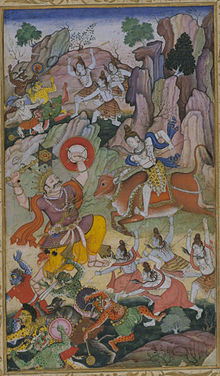Andhaka

Andhaka ( Sanskrit अन्घक andhaka "blind") is the asura of blindness, ignorance and darkness in Hinduism . Andhaka is said to have been the child of the demon king Hiranyaksha . However, after the Vamana Purana he was the blind born child of Shiva .
Legends of origin
When Parvati once playfully covered the eyes of the meditating Shiva, the world darkened and in that hour Andhaka was born, who, as a child of darkness, was blind from birth. Shiva asked the hitherto childless Hiranyaksha, who had asked for a son in persistent ascetic exercises ( tapas ), to accept the blind child for his son. According to another birth legend, Andhaka was the child of Kashyapa and Diti ; Legend has it that he had 1,000 heads, 2,000 eyes, and 1,000 feet, and although not blind, he was called Andhaka because he walked staggering and unsteady like a blind man.
Eventually Andhaka became ruler of the demons and, through persistent practice of tapas, finally succeeded in getting Brahma to grant him a wish: nothing and no one should be able to kill him as long as he does not cast lustful glances at his own mother, which Andhaka is impossible stopped because he said he didn't have any. This gift of Brahma enabled him to be victorious in all battles, ultimately even to defeat the gods and to make himself lord of all three worlds.
Now he wanted Parvati (his own mother) to be a wife and courted her, but was turned away and therefore tried to rape her. In a great battle, Shiva, who came to the rescue, defeated him and impaled him with a trident ( trishula ). According to the condition he could now have found death, but according to the Vamana Purana he remained a prisoner of Shiva for eons until he was just a sack full of bones. Eventually he realized who he was, repented, and became a servant and admirer of Shiva and Parvati under the name of Bhringi .
After the Matsya-Purana , Shiva came into distress during the battle, as new andhakas were constantly sprouting from the drops of blood shed by andhaka. Shiva then created the matrikas , the mothers, who could not master the demon either. Finally, Andhaka was overcome by a being created by Shiva called Shushkarevati , who absorbed all the blood that had been shed and thus destroyed the Andhakas.
According to another version, Andhaka was killed by Shiva because he tried to steal the tree Parijata from the heavenly world Svarga .
As the victor over Andhaka, Shiva is nicknamed Andhakaripu ("enemy of Andhaka") and Andhakasuramardin ("destroyer of Andhaka").
symbolism
Demons (cf. also Mahisasur , Hiranyakashipu , Hiranyaksha ) endanger the existing order - wanted by gods and humans - through their actions. They unite in themselves all evil, d. H. destructive, selfish and ultimately stupid forces. They remove people from a peaceful coexistence in which values such as wisdom as well as inner balance and harmony play a dominant role.
swell
- Matsya Purana 179
- Vamana Purana
literature
- Roshen Dalal: Hinduism. An Alphabetical Guide. Penguin, New Delhi 2010, ISBN 0-14-341421-6 , p. 29.
- Andhaka 1) . In: John Dowson : A classical dictionary of Hindu mythology and religion, geography, history, and literature. Trübner & co., London 1879, p. 15 ( Textarchiv - Internet Archive ).
- Anneliese and Peter Keilhauer: The Imagery of Hinduism. The Indian world of gods and their symbolism. DuMont, Cologne 1986, pp. 201 ff., ISBN 3-7701-1347-0 .
- Veronica Ions: Indian Mythology. Hamlyn Publishing, London 1988, p. 93, ISBN 0-600-34285-9 .
Web links
Individual evidence
- ↑ andhaka . In: Monier Monier-Williams : Sanskrit-English Dictionary . Clarendon Press, Oxford 1899, p. 45, col. 1 .
